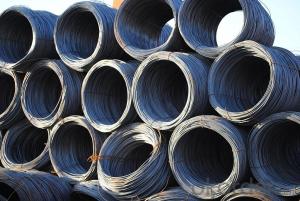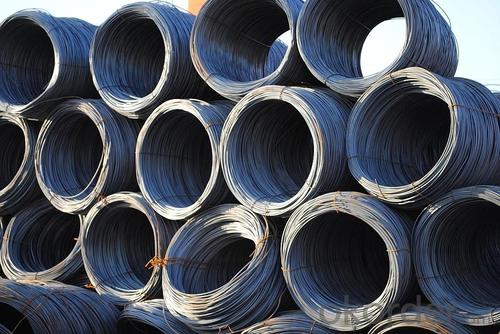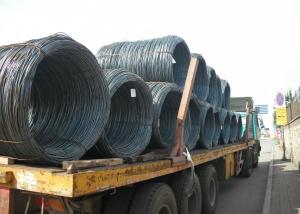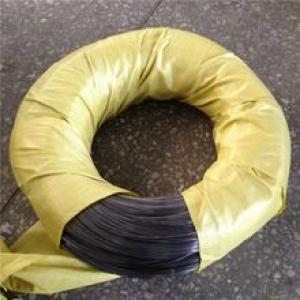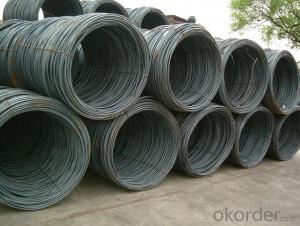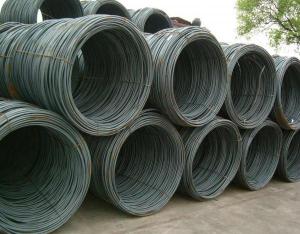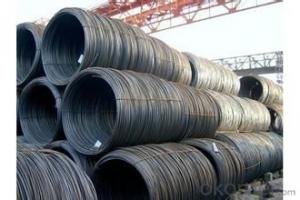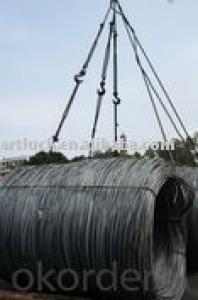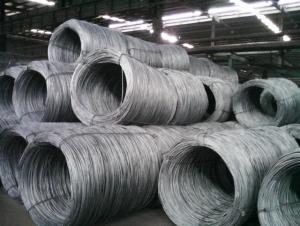Carbon Steel Wire Rod 7mm
- Loading Port:
- China Main Port
- Payment Terms:
- TT OR LC
- Min Order Qty:
- -
- Supply Capability:
- -
OKorder Service Pledge
OKorder Financial Service
You Might Also Like
Specifications of Steel Wire Rod in Coil:
Steel Grade: Q195/235, SAE1006-1018B Standard: ASTM, GB
Diameter: 6.5mm
Type: Drawn Wire Alloy or Not: Alloy Brand Name: HSKY
Technique: Hot Rolled Place of Origin: China Mainland
Chemical Composition:(Please kindly find our chemistry of our material based on SAE1006B and SAE1008B as below for your information)
Grade | Chemical Composition (%) | |||||
C | Mn | S | P | Si | B | |
SAE1006B | 0.03~O.07 | 0.32max | 0.045max | 0.040max | 0.30max | 0.0008min |
Mechanical properties | ||||||
Yield strength(N/mm2) | Tensile strength(N/mm2) | Elongation (%) | ||||
250-280 | 350-380 | ≥32 | ||||
Grade | Chemical Composition (%) | |||||
C | Mn | S | P | Si | B | |
SAE1008B | 0.10max | 0.3~0.50 | 0.050max | 0.040 max | 0.15max | 0.0008 min |
Mechanical properties | ||||||
Yield strength(N/mm2) | Tensile strength(N/mm2) | Elongation (%) | ||||
≥195 | 315-430 | ≥30 | ||||
- Q: What are the different types of steel wire rod surface defects and their detection methods?
- During the manufacturing process, various types of defects can occur on the surface of steel wire rods. These defects can have a significant impact on the quality and integrity of the wire rods, so it is crucial to identify and address them before they cause further issues. Here are some common surface defects of steel wire rods and the methods used to detect them: 1. Scale: Oxide layers can form on the surface of wire rods due to exposure to high temperatures during production. Scale can be visually detected by looking for discoloration or by performing a scratch test to see if the scale flakes off easily. 2. Cracks: Surface cracks can be caused by factors like improper cooling, excessive stress, or material defects. Visual inspection is commonly used to detect cracks, but more accurate methods like magnetic particle inspection or ultrasonic testing can also be utilized. 3. Pitting: Pitting refers to small depressions or cavities that form on the surface of wire rods due to corrosion or mechanical damage. Visual inspection is usually sufficient to identify pitting, but techniques like dye penetrant inspection or eddy current testing can be employed for a more detailed examination. 4. Surface roughness: Irregular or uneven texture on the surface of wire rods is known as surface roughness. It can be a result of improper manufacturing processes or inadequate quality control. Visual inspection or the use of a profilometer to measure roughness quantitatively can help detect surface roughness. 5. Inclusions: Non-metallic substances, such as slag, dirt, or oxide particles, can become embedded in the surface of wire rods, causing weak spots or affecting mechanical properties. Visual inspection can identify large inclusions, while microscopic examination or techniques like X-ray inspection can detect smaller or subsurface inclusions. 6. Coating defects: If a wire rod has a coating, defects like peeling, blistering, or uneven thickness can occur. Visual inspection is generally sufficient, but techniques like ultrasonic testing or electrical conductivity measurements can provide a more comprehensive assessment. It is important to note that while visual inspection is commonly used, more advanced non-destructive testing (NDT) methods can offer more accurate and reliable detection of surface defects. By employing a combination of these methods, the identification and rectification of surface defects in steel wire rods can be ensured, ultimately enhancing their quality and performance.
- Q: What are the common manufacturing defects found in steel wire rod?
- Some common manufacturing defects found in steel wire rods include surface cracks, inclusions (foreign materials trapped within the metal), uneven or improper coating, incorrect dimensions or shape, and non-uniform hardness or strength.
- Q: How is steel wire rod used in the manufacturing of wire for power transmission lines?
- The manufacturing process for wire used in power transmission lines relies heavily on steel wire rod. This essential component serves as the raw material for creating high-strength conductors that carry electrical energy across vast distances. To begin the manufacturing process, high-quality steel wire rods are carefully selected. These rods are typically made from either carbon steel or alloy steel. They then undergo a series of processes, including heating, rolling, and drawing, to transform them into wires with specific diameters and strengths. The primary role of the steel wire rod is to provide the necessary mechanical strength and conductivity required for power transmission lines. Steel is known for its exceptional tensile strength, which enables the wire to withstand the immense tension and stress experienced during installation and operation of transmission lines. Moreover, steel wire rod offers excellent electrical conductivity. This means that it allows electricity to flow efficiently through the wire, minimizing power loss and ensuring optimal transmission efficiency over long distances. The manufactured wire, which is made from steel wire rod, is typically stranded together to create a conductor. Multiple layers of these steel wire strands are then wound around a central core to form a composite conductor. This design enhances the wire's strength and flexibility, making it suitable for enduring extreme weather conditions, wind, and ice loads. Furthermore, steel wire rod plays a critical role in ensuring the durability and reliability of power transmission lines. Its corrosion resistance properties protect the wire from environmental factors such as moisture and chemical exposure, which could otherwise compromise the integrity of the line. To summarize, steel wire rod is essential in the manufacturing of wire for power transmission lines due to its exceptional tensile strength, electrical conductivity, and corrosion resistance properties. It enables the production of high-quality conductors that can efficiently transmit electrical energy over long distances while enduring various environmental challenges and ensuring uninterrupted power supply.
- Q: How is steel wire rod used in the manufacturing of wire forms for electrical connectors?
- Steel wire rod is commonly used in the manufacturing of wire forms for electrical connectors due to its high strength and conductivity properties. It serves as the primary raw material for producing wires of various gauges and diameters, which are then shaped into specific forms required for connectors. These wire forms are crucial components in electrical connectors as they provide secure and reliable connections between different electrical components, ensuring efficient power transmission and signal integrity in various applications.
- Q: What are the main factors affecting the quality of steel wire rod?
- There are several main factors that affect the quality of steel wire rod. Firstly, the chemical composition of the steel plays a crucial role. The presence of impurities, such as sulfur and phosphorus, can significantly impact the strength, ductility, and overall quality of the wire rod. Therefore, strict control over the chemical composition is essential to ensure high-quality steel wire rod. Secondly, the manufacturing process and the quality of raw materials used are important factors. The steelmaking process, including melting, refining, and casting, must be carefully controlled to avoid any contamination or defects that could weaken the wire rod. The quality of the raw materials, such as iron ore and scrap metal, also affects the final product. Using high-quality raw materials can result in enhanced mechanical properties and overall quality of the wire rod. Thirdly, the heat treatment process is crucial in determining the quality of steel wire rod. Proper heat treatment, which involves controlled heating and cooling processes, can significantly improve the mechanical properties of the wire rod, such as tensile strength and hardness. It also helps in reducing internal stresses and improving the microstructure of the steel, thereby enhancing its overall quality. Another important factor is the surface quality of the wire rod. Any surface defects, such as cracks, scale, or unevenness, can adversely affect the wire rod's performance in various applications. Therefore, proper surface preparation and inspection are necessary to ensure a smooth and defect-free surface. Furthermore, the mechanical and physical properties of the steel wire rod, such as tensile strength, ductility, and toughness, greatly impact its quality. These properties are influenced by various factors, including the steel's microstructure, grain size, and the presence of any residual stresses. It is important to control and optimize these factors during the manufacturing process to achieve the desired mechanical and physical properties. Lastly, adherence to stringent quality control measures throughout the entire production process is crucial in ensuring the quality of steel wire rod. Regular testing and inspection of the raw materials, intermediate products, and final wire rod are essential to detect any deviations or defects and take corrective actions promptly. In conclusion, the main factors affecting the quality of steel wire rod include the chemical composition, manufacturing process, heat treatment, surface quality, mechanical and physical properties, and adherence to quality control measures. By carefully controlling and optimizing these factors, manufacturers can produce high-quality steel wire rod that meets the desired specifications and performance requirements.
- Q: What are the main factors affecting the market consolidation of steel wire rod?
- The main factors affecting the market consolidation of steel wire rod are the demand-supply dynamics, industry competition, economies of scale, and regulatory factors. The demand for steel wire rod is influenced by the overall economic growth, infrastructure development, and construction activities. The level of competition within the industry, including the number and size of market players, consolidation trends, and pricing strategies, also plays a significant role in market consolidation. Additionally, the ability to achieve economies of scale through efficient production processes and cost optimization is crucial for market consolidation. Lastly, regulatory factors such as trade policies, tariffs, and environmental regulations can impact the market consolidation of steel wire rod.
- Q: What are the main factors affecting the market branding of steel wire rod?
- The main factors affecting the market branding of steel wire rod include the quality and consistency of the product, price competitiveness, the reputation and trustworthiness of the manufacturer, the availability and reliability of supply, the ability to meet customer specifications and requirements, and the effectiveness of marketing and promotional efforts in creating brand awareness and perceived value. Additionally, factors such as technological advancements, environmental sustainability, and compliance with industry standards and regulations can also influence the market branding of steel wire rod.
- Q: What are the different types of steel wire rod processing equipment?
- In the manufacturing and production process, various types of steel wire rod processing equipment are utilized. These equipment have been designed to carry out different tasks and processes, with the aim of converting raw steel wire rods into finished products. Among the diverse range of steel wire rod processing equipment are the following: 1. Wire Drawing Machines: These machines function by pulling the wire rod through a series of dies, resulting in a reduction in diameter. This process enhances the wire's surface finish, accuracy, and strength. 2. Wire Straightening and Cutting Machines: These machines are utilized to straighten and cut the wire rod into desired lengths. They are capable of handling different wire diameters and are commonly employed in the production of wire products such as nails, screws, and wire mesh. 3. Wire Annealing Furnaces: For the purpose of softening the wire rod and improving its ductility and machinability, annealing is employed as a heat treatment process. Annealing furnaces provide controlled heating and cooling conditions, facilitating the attainment of the desired properties. 4. Wire Coiling Machines: These machines are responsible for winding the straightened and cut wire rod into coils. Depending on the volume and size of the coils required, they can be either manual or automated. 5. Wire Galvanizing Lines: In order to protect the wire rod from corrosion, a layer of zinc is applied to its surface through the process of galvanizing. Galvanizing lines are employed to clean, flux, and coat the wire rod with molten zinc. 6. Wire Electroplating Equipment: Electroplating is a technique employed to deposit a thin layer of metal onto the surface of the wire rod, with the purpose of enhancing its appearance or providing specific properties. Electroplating equipment encompasses tanks, rectifiers, and various chemical solutions. 7. Wire Mesh Welding Machines: These machines are utilized to weld the wire rods together, creating wire mesh products such as fences, reinforcement grids, and filter screens. The level of automation varies depending on the complexity of the mesh design. 8. Wire Stranding Machines: In the production of electrical cables and conductors, stranding machines are employed to twist multiple wire rods together, resulting in stranded cables. In conclusion, the diverse range of steel wire rod processing equipment plays a critical role in the manufacturing and production of various wire and steel products. These machines enable the conversion of raw materials into finished products that possess the desired properties and meet the required specifications.
- Q: How is steel wire rod used in the manufacturing of wire for automotive seat frames?
- Steel wire rod is used in the manufacturing of wire for automotive seat frames as it serves as the primary raw material for producing the wire. The steel wire rod is first processed through various mechanical and heat treatment processes to enhance its strength and durability. Once transformed into wire form, it is further used to fabricate the intricate seat frame structures, providing strength and support to ensure safety and comfort for automotive passengers.
- Q: What are the common applications of high carbon and oil tempered steel wire rod?
- Due to their unique properties, high carbon and oil tempered steel wire rod find a wide range of applications. These materials are commonly used in various industries for different purposes, such as: 1. Manufacturing springs: High carbon and oil tempered steel wire rod are known for their exceptional strength, flexibility, and durability. They can withstand high stress and repeated bending, making them suitable for manufacturing different types of springs, including automotive suspension springs, valve springs, and mattress springs. 2. Production of wire ropes and cables: The high tensile strength and resistance to wear offered by high carbon and oil tempered steel wire rod make them a preferred choice for producing wire ropes and cables. These materials are well-suited for applications that involve heavy lifting, such as cranes, elevators, and suspension bridges. 3. Making wire mesh and fencing: The strength and durability of high carbon and oil tempered steel wire rod make them an excellent option for manufacturing wire mesh and fencing products. These materials provide reliable security and can withstand harsh weather conditions, making them suitable for use in construction sites, agriculture, and animal enclosures. 4. Automotive industry applications: High carbon and oil tempered steel wire rod play a significant role in the automotive industry. They are used for manufacturing various components, including engine valve springs, clutch springs, and brake springs. These materials offer high fatigue resistance and can endure the demanding conditions of automotive applications. 5. Construction and infrastructure projects: High carbon and oil tempered steel wire rod are essential in the construction industry for multiple purposes. They are used to reinforce concrete structures like beams, columns, and precast elements. The high strength and corrosion resistance of these materials make them capable of withstanding the stresses and environmental conditions encountered in construction projects. 6. Industrial machinery production: High carbon and oil tempered steel wire rod also find applications in manufacturing industrial machinery and equipment. They are used in the production of conveyor belts, machine components, and wire forms. These materials provide the necessary strength and flexibility required for the smooth and efficient operation of industrial machinery. In summary, high carbon and oil tempered steel wire rod have wide-ranging applications in various industries. Their unique combination of high strength, durability, and flexibility makes them suitable for use in springs, wire ropes, wire mesh, automotive components, construction reinforcement, and industrial machinery.
Send your message to us
Carbon Steel Wire Rod 7mm
- Loading Port:
- China Main Port
- Payment Terms:
- TT OR LC
- Min Order Qty:
- -
- Supply Capability:
- -
OKorder Service Pledge
OKorder Financial Service
Similar products
Hot products
Hot Searches
Related keywords
